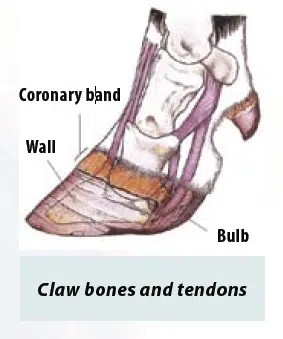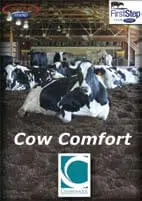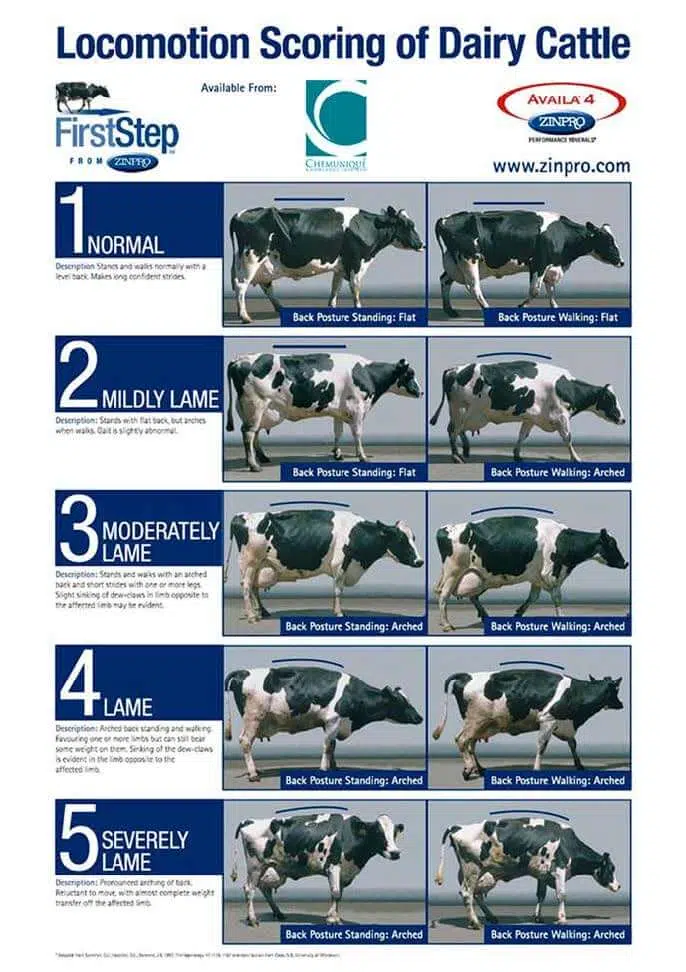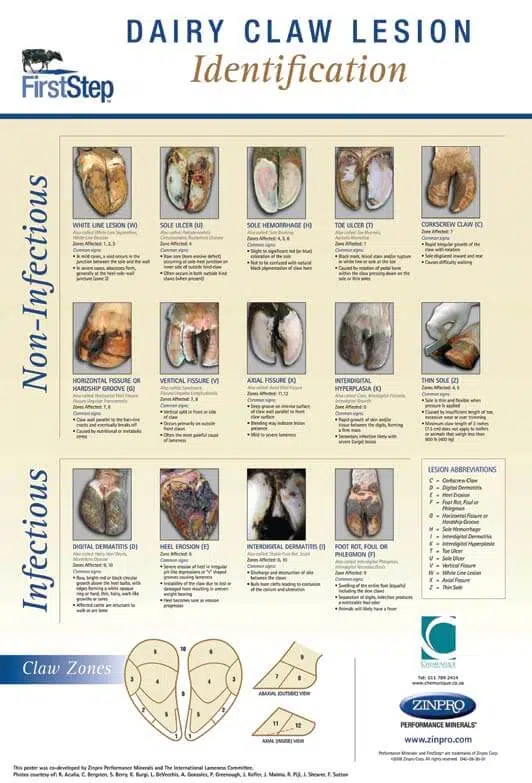The importance of cow comfort
Lameness reduces the overall profitability of a dairy operation. The effects of lameness can be subtle and have many levels of severity.
Invariably, lameness is associated with pain, decreased dry matter intake, a loss of body condition, decreased milk production, increased reproductive failure and mastitis, often leading to expensive treatment or even culling. Factors affecting lameness and locomotion include nutrition, the environment, claw trimming and health events resulting in the production of poor quality horn. The identification and management of problem areas in an individual herd can be challenging.
When looking at the housing and management of dairy cows with regard to cow comfort, one has to consider flooring surfaces, the length of time standing, stall comfort and exercise. It is important that walking surfaces provide maximum traction with minimum chances for foot or claw injury. By grooving concrete surfaces, animal traction is improved and the potential for slips and falls is reduced. It is also recommended that soft, wet and manure laden surfaces are avoided, as claws become softer and are more prone to lameness due to penetration by foreign objects. Cows also alter their walking rate and step length, as well as angle, when on wet or slippery floors, which could cause abnormal wear and increased shearing forces on the white line area of the claw.
I
Too much standing caused by the lack of comfortable places to lie or improperly sized milking facilities reportedly increases the incidence of lameness. Sand bedded stalls provide a more comfortable lying surface than sawdust or mattresses, and are also cleaner, cooler and more hygienic, while also improving footing on manure covered concrete. However, sand is not without risk, as it may lead to increased claw wear, resulting in thin soles and therefore it needs to be managed properly. Extended exposure to hard, unforgiving walking surfaces should also be avoided.
Cows and heifers should be adapted to new housing facilities/flooring before parturition, as this is usually a significant change from the dry period/rearing environment. Animals that are not adapted to new conditions are more susceptible to lameness.
There are also physiological changes that occur around calving, where the hypothesis is that the increase in the hormone relaxin (to help with expulsion of the calf) also increases the elasticity of the connective tissue suspending the pedal bone in the claw capsule, which could result in increased sole ulcers and white line lesions around calving.
Dairy managers should pay attention to all areas of cow comfort to minimise the incidence of lameness-causing factors and improve overall claw health to positively affect performance and profitability.
Cows with healthy feet eat, milk and breed better
There is much discussion about the relationship between nutrition and lameness with regard to the level of effective fibre, amount of grain, fermentation rates of grain, forage-to-grain ratios in the dairy cow ration and a subsequent acidosis-laminitis link. It is very evident that certain feeding regimes, diets, metabolic upsets and infectious diseases result in significant and prolonged drops in rumen pH, dramatically increasing the incidence of lameness.
Key factors in the cascade of events are feeding management, moulds/mycotoxins (feed/forage quality), infectious disease and metabolic disorders, environment and genetics. Many of these variables lead to ruminal upsets, resulting in the death of gram negative bacteria and the production of endo-/exotoxins, resulting in a vaso-constriction/dilation response within the claw. This upset in blood and nutrient flow results in the production of a poor quality horn and, if severe enough, the death of laminar horn tissue and acute lameness.
An area of nutrition that is commonly overlooked, is the role of trace minerals in improving claw health, structural integrity and reducing the incidence of lameness.
Zinc improves claw integrity by speeding wound healing, increasing the rate of epithelial tissue repair and maintaining cellular integrity. It is also required for the synthesis and maturation of keratin. In a year-long study conducted at Illinois State University, cows fed complex zinc showed fewer cases of heel cracks, interdigital dermatitis and laminitis.

Manganese plays an important role in cartilage and collagen formation, as well as bone growth and thus helps minimise feet problems by maintaining proper leg formation and production of quality horn. Supplementation in late gestation should be considered, as manganese status in the cow is lowest at this time.
Florida research indicates that replacing inorganic forms of zinc, manganese, copper and cobalt with those from Zinpro Performance Minerals, beginning in the dry period and continuing through lactation, reduced the incidence and severity of claw disorders. The overall incidence of claw disease, for example, decreased by 30,8% as early as 75 days postpartum, with a further reduction of
43,5% by 250 days in milk.
Lameness is an issue of extreme importance in every dairy and dairy producers who take an aggressive approach to foot management can attest to the fact that cows with healthy, pain free feet, eat better, milk better and breed better.
Talk to your nutritionist or feed sales representative about the inclusion of Zinpro performance minerals in the diets of your dairy cattle.
Identifying dairy cow lameness
As reported in our previous articles, lameness is a costly disease and reducing its incidence has direct ties to improvements in dairy performance and overall profitability. So how do we identify lame cows?
Locomotion scoring
“The first step in reducing lameness is to determine its incidence and severity on the dairy,” notes Dr Mike Socha, dairy research specialist with Zinpro Performance Minerals, adding: “Many dairy producers today are using locomotion scoring to help find lame cows.”
In this system, cows are scored from 1 to 5, based upon observation of the cow standing and walking, with special emphasis on the cow’s back posture.
The arched back, without the appearance of favouring a limb, has been recognised for some time as an indicator of cows experiencing discomfort in their feet, as cows arch their back to alter weight distribution. In addition, research shows that of the behaviours exhibited by cows with claw lesions, spinal curvature had the highest numerical correlation to the presence of claw lesions.
Cows that score a 2 or higher should be examined by a hoof trimmer. Promptly examining and treating cows that show mild discomfort is important to prevent cows from developing more serious lesions and therefore a reduction in productivity. A poster showing locomotion scores 1 to 5 is a tool every dairyman should have displayed.
Claw lesion identification
In order to determine the best course of action to reduce lameness on the dairy, claw lesions must be accurately identified and recorded. Several systems are used to record claw lesions, ranging from simply recording the cow identification and treatment, to systems in which an extensive list of information, like lesion and location, is recorded. However, the most important point is to have accurate information and to use it to implement a lameness reduction programme.
The International Lameness Committee recently produced a poster showing the most common claw lesions in dairy cattle and how to correctly identify them.
Once lesions have been recorded, data should be analysed to determine what lesions are most prevalent and to determine if there is any seasonality or stage of lactation effect. To help with record interpretation and treatment, lesions should be classified as infectious or non-infectious lesions. The appropriate corrective and preventative actions to reduce lameness will be based upon whether the pain is caused by infectious or non-infectious lesions.
Why is there a need for these posters?
- The knowledge and understanding of the cause, treatment and prevention of lameness has expanded dramatically.
- The posters represent a global consensus for lameness identification – by adopting consistent terminology throughout the world, both the prevalence and economic impact of various lesions will be easier to track and assess.
- Accurately identifying a specific type of lesion is critical for treatment and prevention plans; generic lesion terms are not beneficial. In the past, it was typical for several different types of claw lesions (white line, sole ulcer or sole haemorrhage) to generically be identified as laminitis. In order to accurately identify the cause of the lesion and determine the proper corrective action plan, it is critical to be more specific and consistent.
Who developed the poster?
The dairy claw lesion identification poster was developed through a combined effort of Zinpro Corp and the International
Lameness Committee, a collaboration of researchers, veterinarians, academia and hoof trimming professionals
from around the world.
Key features:
- Ease of use: a practical, user-friendly visual guide to help accurately identify lame cows/claw lesions; includes photos and common signs.
- Global application: uses a consistent, single-letter abbreviation for each lesion.
- Cross-reference ID: provides the ability to cross reference lesion type with the particular claw zone(s) where each lesion occurs, resulting in more accurate lesion identification. Each particular type of lesion has a limited number of causes, therefore accurate lesion identification helps to increase the understanding behind the lesion’s true cause so that an effective correction plan can be implemented.
- Separate categories: lesions organised into infectious and non-infectious categories. Effective claw lesion management starts by evaluating which category (infectious or non-infectious) is most prevalent on a particular dairy. Corrective action plans must be appropriate for the category of lesion. For example, using a footbath programme to treat and prevent non-infectious lesions will not remedy the problem.
FirstStepTM
Until now, there has not been an objective, methodical system to assess the many factors that contribute to lameness. With the FirstStepTM lameness assessment and prevention programme, it all changes. The programme was developed in a combined effort of the University of Wisconsin’s lameness expert, Dr Nigel Cook and Zinpro Corporation. FirstStepTM provides the dairy industry’s first ever comprehensive assessment of overall lameness risk factors.
Data is gathered from up to 20 different assessment models, which the programme then uses to help identify factors that increase the risk of cows becoming lame. FirstStepTM also provides a comprehensive resource library for dairy operations, including videos, articles and other visual resource tools. These will help to educate dairy personnel about lameness, its causes and effects, and possible treatment options.
No matter how many different scenarios exist on a dairy operation, FirstStepTM can be tailored to best fit each situation or type of dairy (pasture or confinement based). The prevention of lameness begins with the assessment of contributing factors. The 20 assessors include some of the key factors to identify the cause of lameness: locomotion scoring, hoof trimming, hygiene and foot baths, claw lesion identification, environment, nutrition and cow management.
Once all the data has been captured, FirstStepTM offers recommendations on possible treatments to remedy the situation in a simple, easy to understand, but comprehensive report. Zinpro Corporation and Chemuniqué International, together with industry commitment and education on lameness related issues are providing the first step towards ensuring that the animals in today’s food and fibre industry will provide a positive return on investment for producers into the future.
For more information on any of the lameness tools or copies of the posters, please contact Chemuniqué on 011 789 2414 or nutri@chemunique.co.za.
Chemuniqué empowers feed and food producers with the most innovative animal performance solutions, enabling our clients to consistently advance the efficiency of production.











